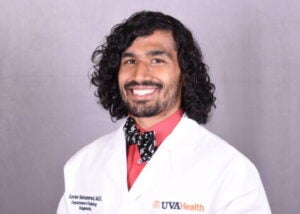 New and prospective residents are often curious about what their daily life will be like at UVA Radiology. And in this time still defined by COVID-19, how does the virus impact that residency experience? Here’s a typical day described by Xavier Mohammed, one of our third-year diagnostic radiology residents.
New and prospective residents are often curious about what their daily life will be like at UVA Radiology. And in this time still defined by COVID-19, how does the virus impact that residency experience? Here’s a typical day described by Xavier Mohammed, one of our third-year diagnostic radiology residents.
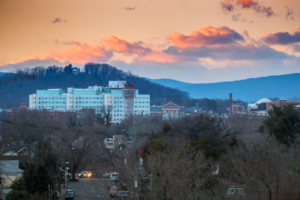
6:30 – 7:15 am: Wake Up!
My alarm goes off at 6:30am. I hit snooze. It goes off again at 6:35am. I guess it’s time to get up! I roll out of bed and grab some fruit, yogurt and coffee. At 7:00am, I grab the rest of my stuff: my badge, phone pager, and most importantly a face mask. I make my way to the hospital. I truly enjoy my daily 15-minute walk through beautiful Charlottesville – I get an amazing view of the mountains on my hilly stroll to work, prepping me for a busy but super fulfilling day of radiology!
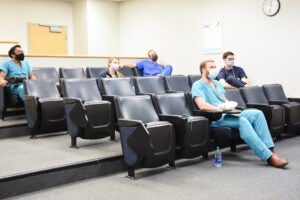
7:15 – 8:00 am: Case Conference
Tuesday through Thursday we have case conferences in the morning before work. In the past we would have all forty residents sit in Moss, our dedicated radiology auditorium, while an attending or fellow pulled up interesting cases to go over. These days, our faculty have made an impressive effort to keep us safe and distanced while ensuring our education continues. So this morning just ten residents, who have signed up prior to the conference, sit in Moss. Seats are assigned in such a manner to ensure we are all at least six feet apart. The other residents tune in virtually from different locations, such as the resident lounge or reading rooms.
Today we have Musculoskeletal conference, one of my favorites! Dr. Nicholas Nacey, one of our MSK attendings, runs the show. He pulls up a case and I summon the courage to volunteer to take on this first case of the conference. It’s an MRI of the shoulder, my favorite joint in the body! I quickly name the planes and sequences of the images, then move on to systematically assess each part of the joint. Dr. Nacey provides encouragement along the way. Rotator cuff tendons? Normal. Glenohumeral ligaments? Normal. Labrum? I think it’s torn! I stick to my gut instinct. When I’m done reaching to my conclusion, he gives me feedback on what I did well and what I could work on for next time. He then pulls up the second case, and one of my colleagues volunteers virtually to take it on. Eventually it’s 8:00am, and while our attendings seem to have an unlimited number of great cases up their sleeve to go over, we are let out to each go to our respective services for the day.
8:00 am – noon: Clinical Service
Today I am on ultrasound. Each of my fellow residents goes to the other subdivisions: chest, musculoskeletal, pediatrics, just to name a few. I stay in Moss, which is where we have our body procedure ‘huddle,’ where we review all the ultrasound and CT procedures for the day and assign cases. Sara, our mini-fellow, assigns us our cases for the day. After huddle, I make my way to the body reading room, where all body ultrasounds, CTs, and MRIs are read. As I enter, I see the fellows and attendings at their stations, all masked up. I log onto PACs, grab some high priority cases, and start cranking through them. There is always quite the variety: rule out ectopic pregnancy, concern for cholecystitis, deep vein thrombosis study, etc. I try my best to go quick, as these can be emergent cases, without compromising accuracy.
When I get a break, I grab Dr. Arun Krishnaraj to go over the cases. I like reading out with Dr. Krishnaraj because he almost always brings up some new literature that is very interesting and super helpful for expanding my practical knowledge base. Just as we finish reading out, I’m paged by one of our radiology nurses for my chest tube placement. I confirm the patient is COVID negative, then head over and introduce myself to the patient, who has been struggling with recurrent pleural effusions due to cirrhosis. We are hoping the chest tube will ease his chest pain and shortness of breath. After consenting him, I clean and prep him. The procedure leader for day, Dr. Rebecca Dameron, pops in and we start the procedure. My ultrasound probe immediately shows a large effusion. I steady my probe between two rib shadows, do a quick Doppler shot to confirm there aren’t any blood vessels in my way, and numb down to the pleura with lidocaine. I give it a second to set it, then use my needle to guide my chest tube into the pleural space. Once I’m in I pull my needle out, suture the tubing in place, pull some fluid for labs, and attach my tube to suction. Soon after, my patient begins noting improvement with his respirations. It’s very fulfilling to be providing patient care on both the diagnostic and therapeutic ends of medicine, splitting time between reading images and doing image-guided procedures.
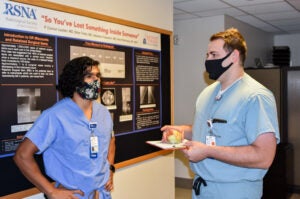
Noon – 1:00 pm: Noon Didactics
At noon, the fellows/attendings keep lookout for high priority scans as the residents break for lunch and didactics. 12:00-1:15pm is always protected; the attendings do a great job of maintaining that. I grab some sushi and soda from the cafeteria, then make my way back to Moss auditorium. Once again, it’s just ten residents in the room, spaced out so that we can unmask and eat while maintaining safe social distancing. Soon Dr. Auh Wan Park, one of our interventional radiologists, walks in and pulls up his presentation. Just like for case conference, the other residents log in remotely to this didactic lecture. But this is a different sort of learning: we listen in rather than actively trying to go through cases. Both ways of learning are vital to radiology.
Today, Dr. Park is going over the pros and cons of different types of gastrointestinal bleeding imaging. By the end of the lecture, I feel I have a better grasp on recommending the appropriate study when a concerned physician is worried about a GI bleed in their patient: Tagged RBC scan, CTA or angiogram. In the final five minutes, Dr. Park reminds us to stay positive and vigilant in our work in the hospital during this difficult time. I really like how he ended lecture on such a nice and considerate note!
1:00 – 1:15 pm: Break
Once the lecture ends, I head outside for a few minutes to get some fresh air, stretch my legs and soak in some sunlight after all that time in the dark! We always have a few minutes after conference to take a short break to catch our breath before resuming our work.
1:15 – 5:00 pm: Clinical Service
Soon I’m back at work once again. I quickly do a fine needle aspiration on a large thyroid nodule and do a liver biopsy to finish up my procedures for the day. Afterwards, I continue to tackle as many high-priority ultrasounds as I can, as this is what I will see when I am on call. Things slow down a bit in the afternoon, so I get a chance to grab some outpatient ultrasounds as well, such as transplant follow ups, thyroid nodules and menorrhagia work ups. I do a few more read outs with Dr. Krishnaraj, making mental notes along the way of things I could improve in. Before I know it, it’s five o’clock and the work day is over! I see the swing shift residents migrating into the body reading room for their 5:00 – 8:00 pm shift, which we each take every two to three weeks. The rest of us slowly trickle out as we finish up our dictations.
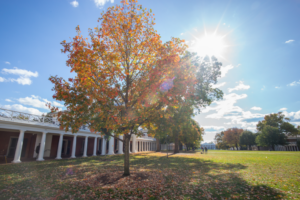 5:00 – 6:00 pm: Work Out!
5:00 – 6:00 pm: Work Out!
Every day I commit 9 – 10 hours to the mental exercise that is radiology; now it’s time for some physical exercise! As an active person and competitive athlete, Charlottesville is a perfect place for me. The pandemic hasn’t changed the fact that it’s such a beautiful place to workout. I make my way to a clear patch of grass on the ‘The Lawn.’ After some quick stretches, I blast out some push ups, pistol squats and pull ups, using one of the trees as a pull up bar. These days I have to improvise with my workout routine a bit! After my bout of strength training, I practice a variety of flips and tumbling maneuvers on the soft, well-manicured grass. I see other people from a distance working out too; some are running, others are also doing calisthenics, and some are just taking a casual walk with their dog.
6:00 – 10:00 pm: Relax and Study
After working out, I head back home to clean up, cook and wind down for the day. Next week I start neuroradiology, so I spend sometime reviewing my neurovascular anatomy as well as some MRI basics. Afterwards, I give my parents and younger brothers a quick call. My parents notice me yawning quite a bit – I guess it’s time for sleep! I tell them goodnight, set my alarm for 6:30 am, and shut my eyes…

Young, Strong, committed and extraordinarily dedicated. What an incredible inspiration.
Dr. Muhammed,
Thanks for sharing your amazing experience. With your story, I can totally imagine the details of a day that you are experiencing as a resident at UVA. This is a great help for an applicant like me.